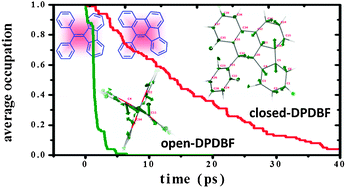Theoretical insight into the aggregation induced emission phenomena of diphenyldibenzofulvene: a nonadiabatic molecular dynamics study
Abstract
The diphenyldibenzofulvene (DPDBF) molecule appears in two forms: ring open and ring closed. The former fluoresces weakly in solution, but it becomes strongly emissive in the solid phase, exhibiting an exotic aggregation-induced emission phenomenon. The latter presents a normal aggregation quenching phenomenon, as is expected. We implement nonadiabatic molecular dynamics based on the combination of time-dependent Kohn–Sham (TDKS) and density functional tight binding (DFTB) methods with Tully's fewest switches surface hopping algorithm to investigate the excited state nonradiative decay processes. From the analysis of the nonadiabatic coupling vectors, it is found that the low frequency twisting motion in the ring open DPDBF couples strongly with the electronic excitation and dissipates the energy efficiently. While in the closed form, such motion is blocked by a chemical bond. This leads to the nonradiative decay rate for the open form (1.4 ps) becoming much faster than the closed form (24.5 ps). It is expected that, in the solid state, the low frequency motion of the open form will be hindered and the energy dissipation pathway by nonradiative decay will be slowed, presenting a remarkable aggregation enhanced emission phenomenon.

- This article is part of the themed collection: Organic electronics - new physical chemistry insight

 Please wait while we load your content...
Please wait while we load your content...